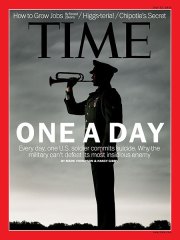
Family photo

family photo
The two soldiers couldn’t have been more different. One was young and handsome enough to be known as “Captain Brad Pitt,” a 2007 West Point graduate trained to deliver ordnance from the Army’s most terrifying flying machine, an AH-64 Apache helicopter gunship. The other was a decade older, a bomb-squad grunt who high school friends had dubbed “Buzzard” because of his pronounced Adam’s apple. In mid-career he shifted gears to become an officer and graduate from the Pentagon’s medical school, where he trained to deliver babies.
While they never met, they had some things in common. Both were Army captains, engaged in important work for the nation, their costly educations paid for by U.S. taxpayers. Ian Morrison, 26, returned to Fort Hood, Texas, last December after nine months flying 70 combat missions over Iraq. Dr. Michael McCaddon, 37, was an ob-gyn resident at Hawaii’s Tripler Army Medical Center. The pilot and the doctor shared one other thing: they found themselves in a darkening, soul-sucking funnel that has trapped some 2,500 military personnel since 9/11. Like them, each died, at his own hand, on March 21, nearly 4,000 miles apart.
 Nancy Gibbs and I tell their stories in TIME this week through the eyes of their widows, Leslie McCaddon and Rebecca Morrison. Although the pair of Army captains ended up at the same place, they got there in different ways. Morrison‘s depression rose like a sudden squall after he came back from Iraq, and, in the three days before he died, vainly sought help six times from the Army. McCaddon‘s gloom had been growing for seven years, but he tried to hide it for fear it would ruin his career. His wife asked for help from an Army that told her that his depression was homegrown and not really its problem.
Nancy Gibbs and I tell their stories in TIME this week through the eyes of their widows, Leslie McCaddon and Rebecca Morrison. Although the pair of Army captains ended up at the same place, they got there in different ways. Morrison‘s depression rose like a sudden squall after he came back from Iraq, and, in the three days before he died, vainly sought help six times from the Army. McCaddon‘s gloom had been growing for seven years, but he tried to hide it for fear it would ruin his career. His wife asked for help from an Army that told her that his depression was homegrown and not really its problem.
(MORE: Military Suicides: Help for Families Worried About Their Service Member)
These are always tough stories to report and write, which may explain why they are so rare.
The Army declined to discuss the two cases. The Pentagon said this week, once again, that there are no easy answers. “Unfortunately, there are not well established and clearly effective interventions to prevent suicides – in general or specifically in a military population during wartime,” Tuesday’s report says. “The findings should be and are deeply concerning to military, medical, and political leaders at the highest levels of the U.S. government.”
We make clear in the story that the military, especially the Army, is striving mightily to try to stop suicide’s surging tide. But the efforts are proving largely ineffective. Too often, over-stretched military mental-health professionals can’t give suicidal patients the time and attention they need.
(MORE: Soldier Suicides: The Stigma of Seeking Help)
Retired general Peter Chiarelli, who until January was the Army’s No. 2 officer and top suicide fighter, remains frustrated. “We have a crisis in the military” caused by a lack of money and personnel to deal with the mental-health challenges created by a decade at war, he tells Time. “Those instances ought to be looked into,” he says of the McCaddon and Morrison suicides.
Such tragedies are inevitable when money is tight and the science of suicide – and how to prevent it – so inexact. “If you have the resource issues that we’ve got in providing behavioral-health help, you are going to have cases like this,” Chiarelli says. “The system is overwhelmed.”


